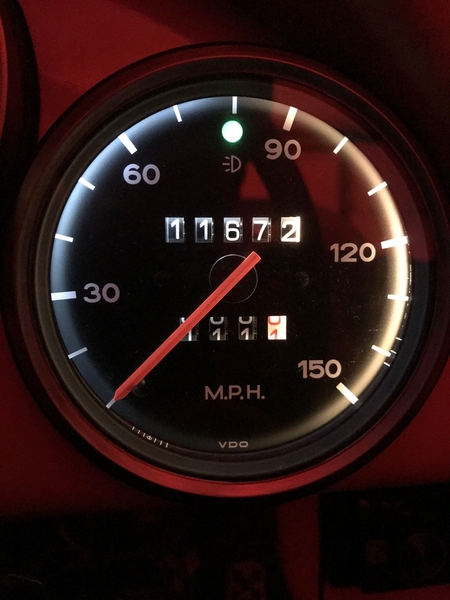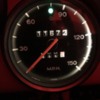*I’ve been enjoying and benefiting from the discussions on this forum for years now, but have remained fairly quiet in part because I wanted to have something of value to add to the conversation. Hopefully this post will be useful to someone and the first of many contributions to come*:
There’ve been other discussions over the years about gauge backlighting, I thought I’d resurrect the topic and add my own update. It seems the dim lighting of the incandescent BA7S bulbs is a common problem. I found that I could barely read my speedo at night, which at minimum is clearly a safety issue, and not an optimal driver experience. Btw I have 914 gauges but my understanding is that 356 gauges have the same problem. I experimented with a few different LED solutions, here’s what I concluded:
OSRAM 12V 2W bulb standard BA7S:
My original incandescents. You already know: Very dim, let’s move on.
The “Jules Dielen” LEDs:
These are my top choice. They’re ~0.23 Watt (my original incandescents are 2W) and 2400K color temp (so they have the same color temp as originals as you can see in the comparison photo), and brighter than my original incandescents. I have to admit, they’re still not super duper bright, but they are clearly significantly brighter and absolutely worth it in my opinion.
Jules mentioned that these LEDs have super lifetime, in fact, he’s got one or more connected to a 12V source in the garage for the past continuous 5 yrs and they’re still going strong. They’re LED after all.
As you can see in the photos, he also provides them with green or blue lens for your fog or high beam indicators. I think this because the bright white light of these LEDs could overpower and wash out the builtin gauge color filter, I don’t think this happened to my gauges, but might as well get the corresponding colored LEDs anyway.
As you can see in the photos, the LED is mounted on the nose of the package. So it mostly illuminates axially (straight out the nose), as opposed to radially (side ways). Still, they’re bright enough to illuminate sideways and thereby light up your gauge face. This is also notable for the 914 combi gauge, where the back light also has a corresponding indicator window on the face, so that always lights up and doesn’t seem to serve any other purpose AFAIK, but it’s fine. For the 356 gauge, the equivalent might be the green indicator that’s between the blue high beam and red battery indicators.
Who’s Jules Dielen? A very kind, knowledgeable, and helpful gentleman that I was pointed to by one of the well-known speedo repair shops. He’s a 356 owner who decided to design LEDs because there wasn’t anything decent commercially available, and simply started offering them to community members because a demand developed. So he’s not out for profit, but instead a helpful community member. If you want his contact info, feel free to PM me, I just didn’t want to put it on blast.
Lastly, I think what he charges is more than reasonable, especially considering the low volume specialized production.
BA7s LED Bulb from SuperBrightLEDS.com:
See https://www.superbrightleds.co...ce_Number,BA7S,1,455
These are also pictured in the attached photos. I’d say they had similar brightness to the Jules Dielen’s LEDs. However, at 6500K, they’re clearly cooler/bluer in color temp. I thought they were too cool/blue for this classic car, it didn’t match, and so I was much happier with Jules Dielen’s LEDs. While on the topic of color, they also come in green or blue.
Lastly, they’re very very affordably priced, but again, to me it didn’t matter if they were free. So I’m just holding on to them as replacements to the incandescents of the indicators… Speaking of, I kept my turn signals as incandescents because I enjoy the classic fade in/out effect. But, if you don't mind the color, these are a great and cheap option.
Few options from discountleds.com (aka autolumination.com):
I never tried any of these, but including my experience for completeness' sake.
Another thread mentioned the Inverted Ba7s, which have an inverted lens to promote radial / sideways illumination, which is what you’d want for a backlighting LED. Search the page discountleds.com/otherleds.htm for these. However, from that vendor, “The inverted are not very bright”. Further, they said that they no longer have any in stock and don’t plan to restock because they don’t sell well. Therefore, I never tried these.
The vendor suggested their “Covered 1 Watt Ba7s 3898 Instrument Panel Gauge Colored Led Bulbs Lights Lamps”, see http://www.autolumination.com/...w_cover_led_bulb.htm . They said “These are also very bright and illuminate in a wide pattern”. I didn’t try these because I was already happy with Jules Dielen’s LEDs, and I’d already learned that 6K color temp is way too blue based on the SuperBrightLEDs bulbs.
The vendor also suggested their “5x 5050 Ba7s T5 Instrument Panel Gauge Colored Led Bulbs Lights Lamps”, see http://www.autolumination.com/...5x_5050_led_bulb.htm . They said “If you have room for the enlarged heads, the 5x 5050 will light sideways and is very bright.” I don’t doubt that these illuminate radially based on the side-mounted LEDs. BUT, they’re 11mm in diameter (too wide for my gauges) and still have the blue color temp problem.
Photos:
In both attached gauge photos, I compare Jules Dielen’s LEDs (always on the right side of the gauge) to the white/bluish SuperBrightLEDs (on the left) and my original incandescent bulbs (on the left). You’ll know which is which. Obviously, these things are hard to capture in photos, but I did my best to capture an accurate comparison. All that ambient red light is from the taillights reflecting in the garage, I’m not in Amsterdam!
In the bulb closeups, leftmost are Jules Dielen LED, middle is SuperBrightLEDs, and rightmost bulb is my original incandescent bulb.
Misc Info:
• Mine are the BA7S (aka BA-7s) bulb standard, not to be confused with the similar but different BA9S. I think BA7S stands for Bayonet 7mm Single (as opposed to Dual bulb/terminal like those larger bulbs in our taillights).
• I’ve come across talk about polarity, i.e., making sure each of yours are either center positive or negative. In my case, everything was center positive.
• Someone at one of the other well-known speedo repair shops not to be named, warned me that LEDs’ heat would cause damage to the gauge face or something like that. I thought this was odd but kept an open mind because sometimes LEDs can be hot contrary to common belief. That said, the LEDs I tested were significantly cooler (in degrees not color temp) wrt the original incandescent bulbs…
• Other search keywords for posterity: Tachometer, speedometer, odometer.









